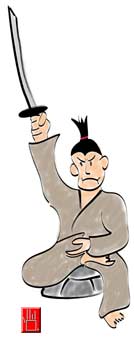On The Way: The Daily Zen Journal
Warrior Zen
Suzuki Shosan (1467-1568)
From the beginning it’s best to do zazen in the midst of strife and confusion…
…What use can there be for a zazen requiring a quiet place? However appealing Buddhist teachings may be, the samurai should throw out anything he can’t use when the moment for his battle cry arrives. So he never needs  anything but the mind of the Nio at all times….
anything but the mind of the Nio at all times….
The Nio are the two guardian deities who stand on either side of the temple gate. Each carries a thunderbolt-like weapon that, according to esoteric Buddhism, symbolizes the diamond-hard wisdom mind.
Suzuki Shosan (1467-1568), former warrior turned monk, seized upon the vital energy symbolized by these two ferocious-looking deities; he emphasized it to students, and demonstrated in his person the need to cultivate it in all activities.
Because of its uniqueness, Shosan became associated exclusively with his Nio zazen as though it were the whole of his teaching. But Nio zazen was only one side of this very complex and distinctive Zen master and cannot be understood unless seen as an integral part of Shosan’s life and teaching, as we read in the following passages:
Eradication of the “I” is the true Dharma
One day a lay person asked: “I’m told that there are mistaken practitioners and true practitioners. How can we distinguish one from the other?”
The Master responded: “When the ‘I’ is eradicated, that is the true Dharma. Practitioners of wisdom establish a ‘wise I.’ Practitioners of compassion establish a ‘compassionate I.’ Practitioners of meditation establish ‘zazen I.’ Practitioners of a particular viewpoint establish an ‘I’ with that viewpoint. Ordinary people tend to elevate themselves. One is always trying to elevate oneself above others. No matter how humble a person’s position, if he upholds the truth, I will step aside for him.”
The determination manifest in Buddhist images
This is called attending to everything within your practice.
If you don’t train yourself with the determination manifest in Buddhist images, your practice will be no use to you. I’ve heard that the main image in Unsen is the Four-Faced Bodhisattva. It is an expression of one’s complete energy being applied in all directions. The Eleven Headed Kannon manifests this same mind. The quiet repose of the Tathagata also embodies this vital energy, complete in every way. Generally when we move in a particular direction, our vital energy focuses solely in that direction, leaving other directions unattended.
Suzuki Shosan (1467-1568) from Warrior Zen – The Diamond-hard Wisdom Mind of Suzuki Shosan edited by Arthur Braverman




Shosan likes to impress upon his students the difficulty and rarity of complete enlightenment. It is with this purpose in mind that he seems to use the symbolism of the many-headed Buddhas and bodhisattvas. They see in all directions while ordinary people see only in one or two or, as Shosan says about himself, three directions. This is another example of Shosan warning his students of the danger of making too much of a small insight.
Suzuki Shosan is among the most dramatic personalities in the history of Zen. A samurai who served under the Shogan in the 17th century, he became a Zen monk at age 41 and evolved a highly original teaching style imbued with the warrior spirit. The warrior’s life, Shosan believed, was particularly suited to Zen study because it demanded vitality, courage, and “death energy,” the readiness to confront death at any moment. Emphasizing dynamic activity over quiet contemplation, Shosan urged students to realize enlightenment in the midst of their daily tasks.
Within Shosan’s words we feel a different meaning to the term “warrior” so often used today. A true authenticity breathes through his words, and one is awed by how a word pales with the passages of time….
Dedicated to all those who seek the Way,
In Peace,
Elana, Scribe of Daily Zen